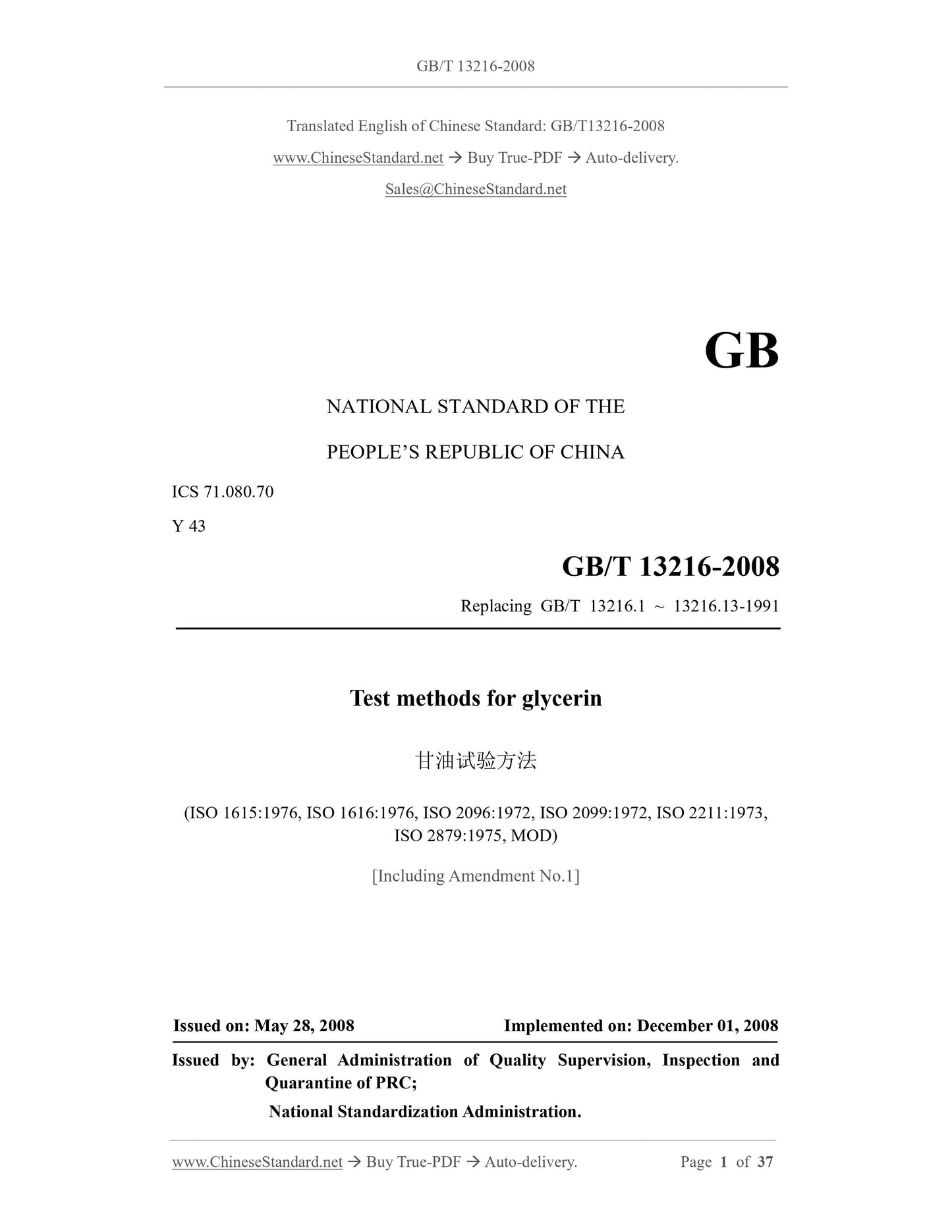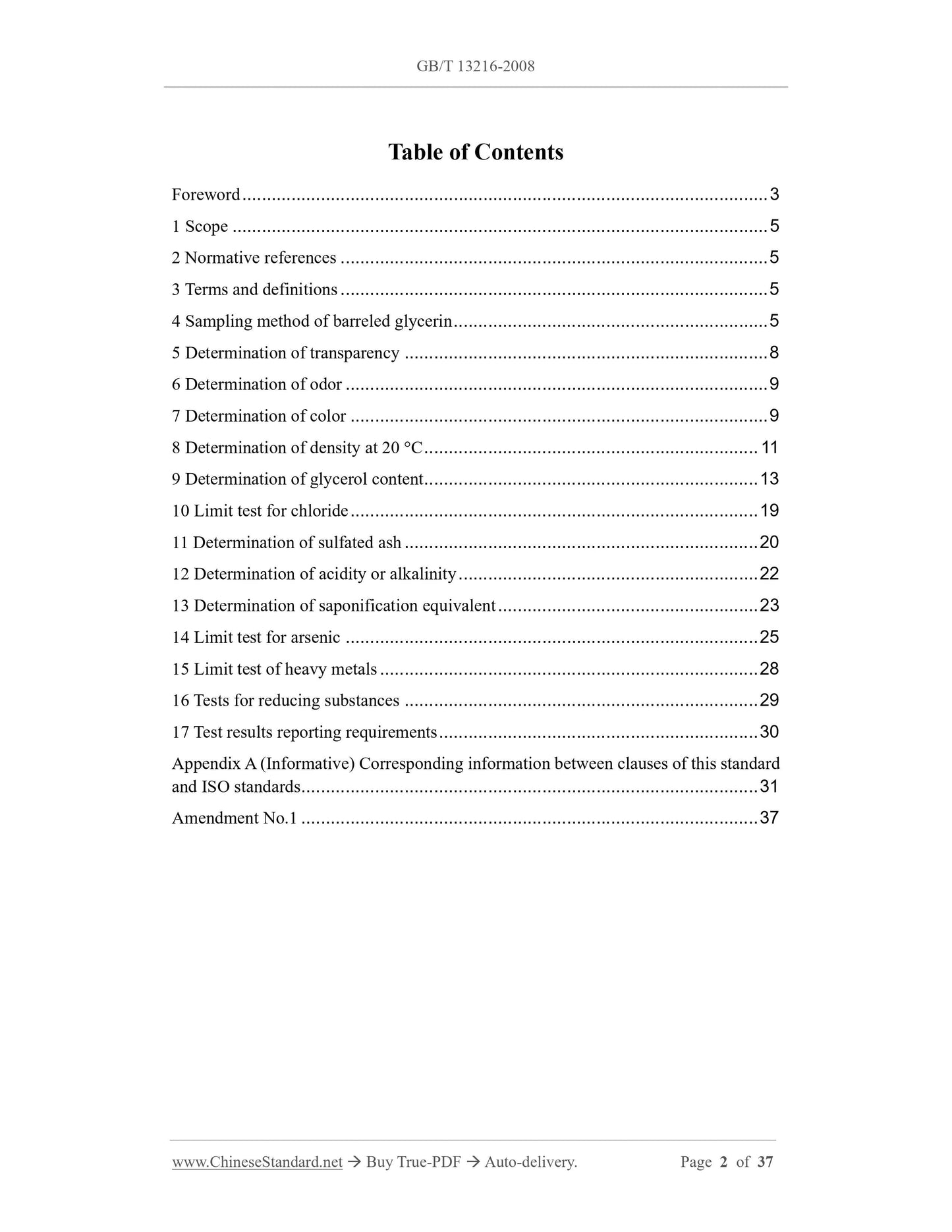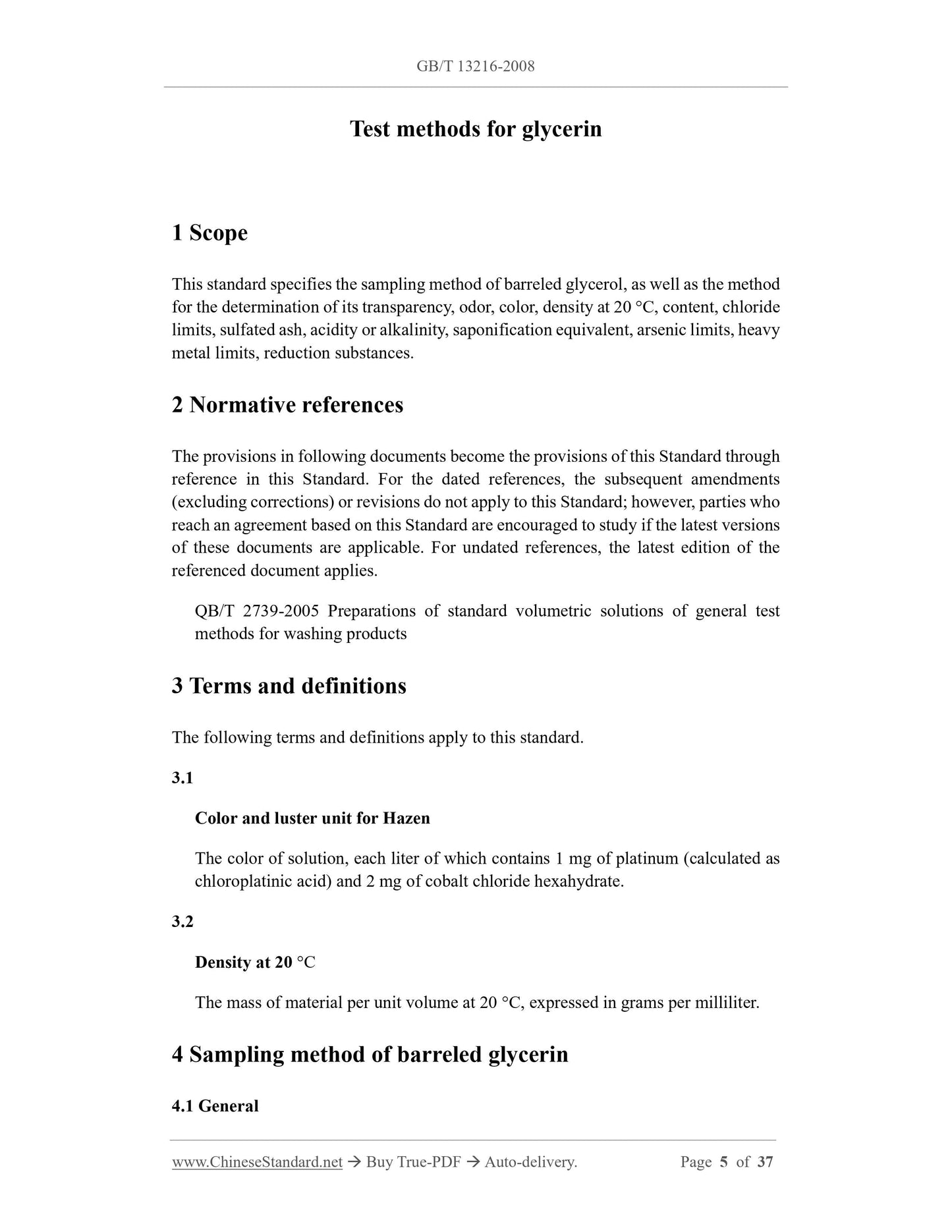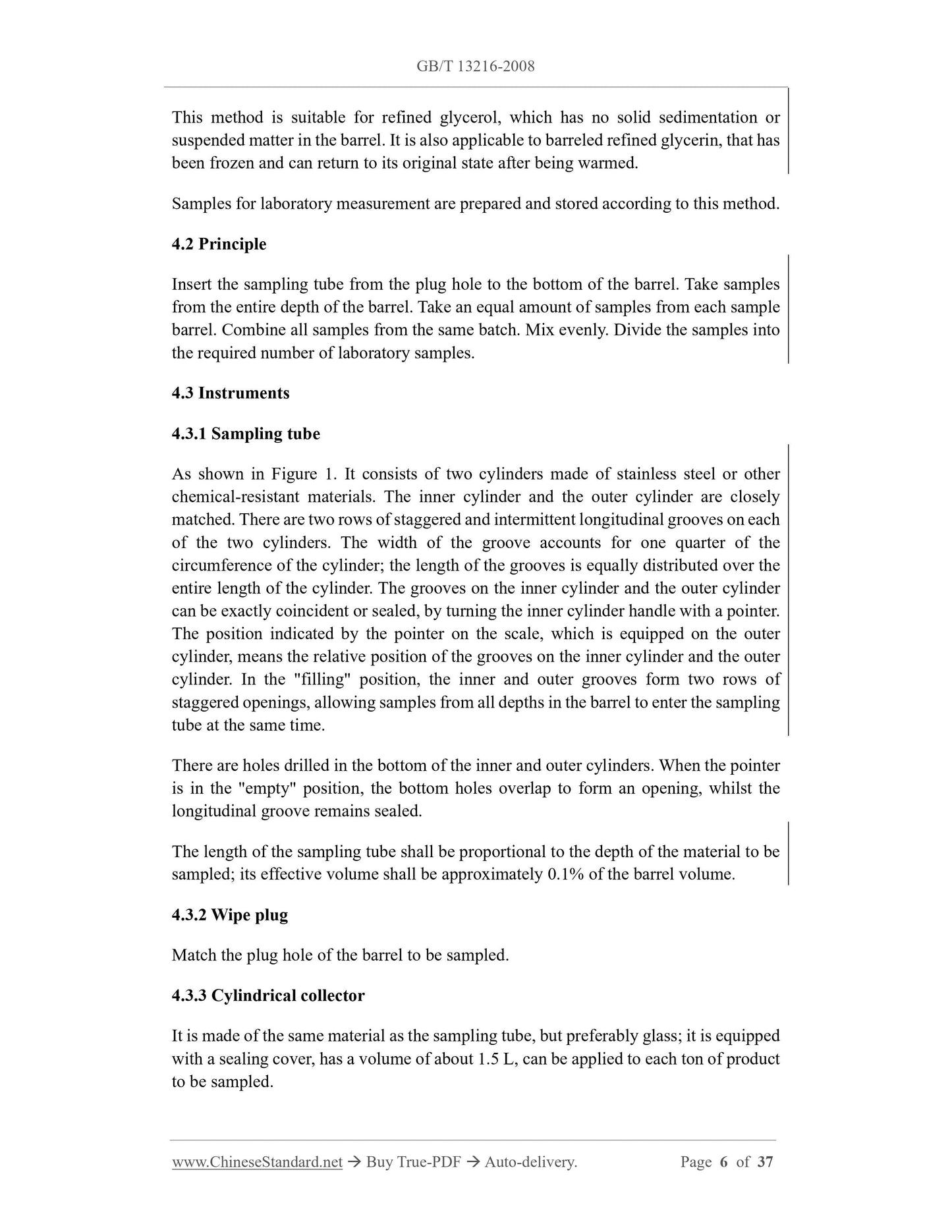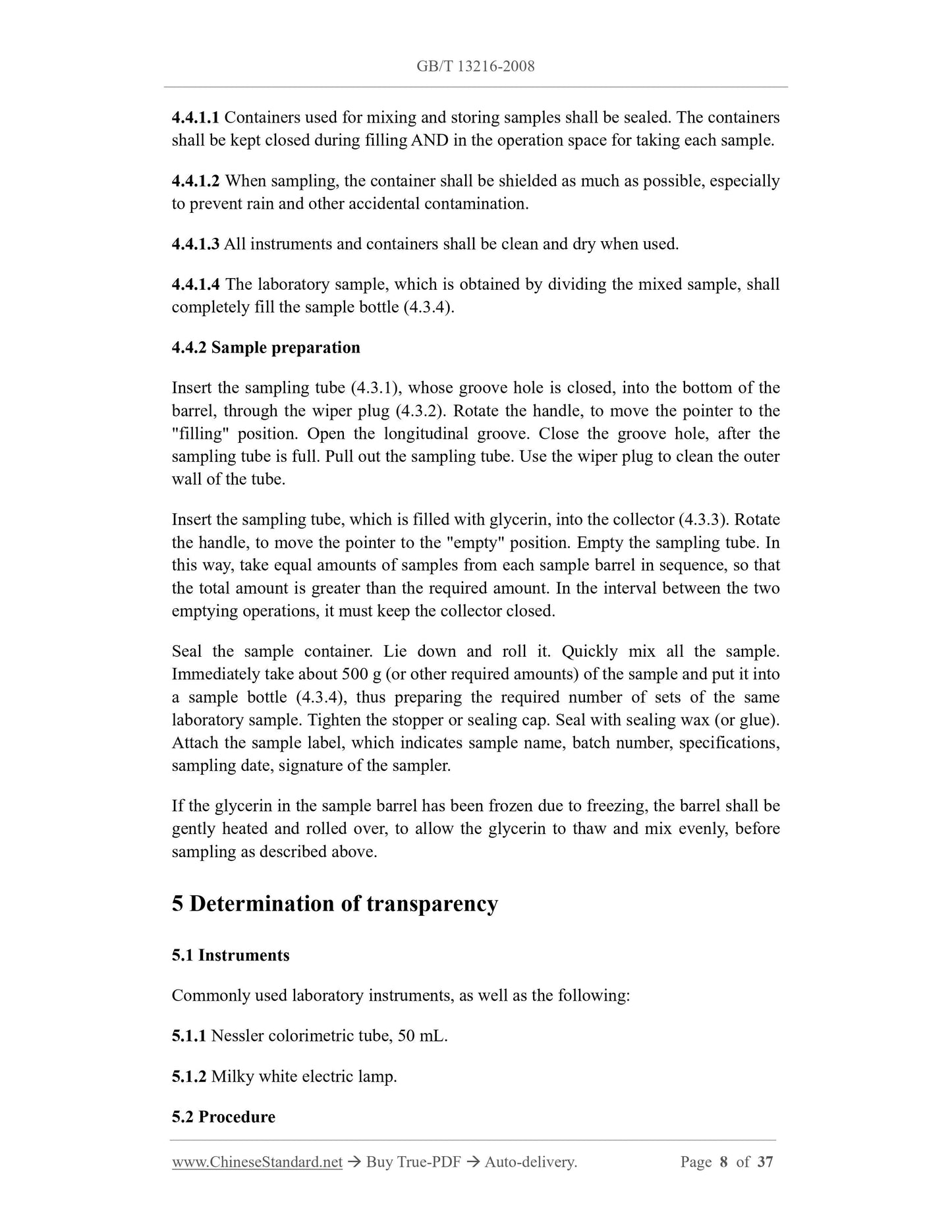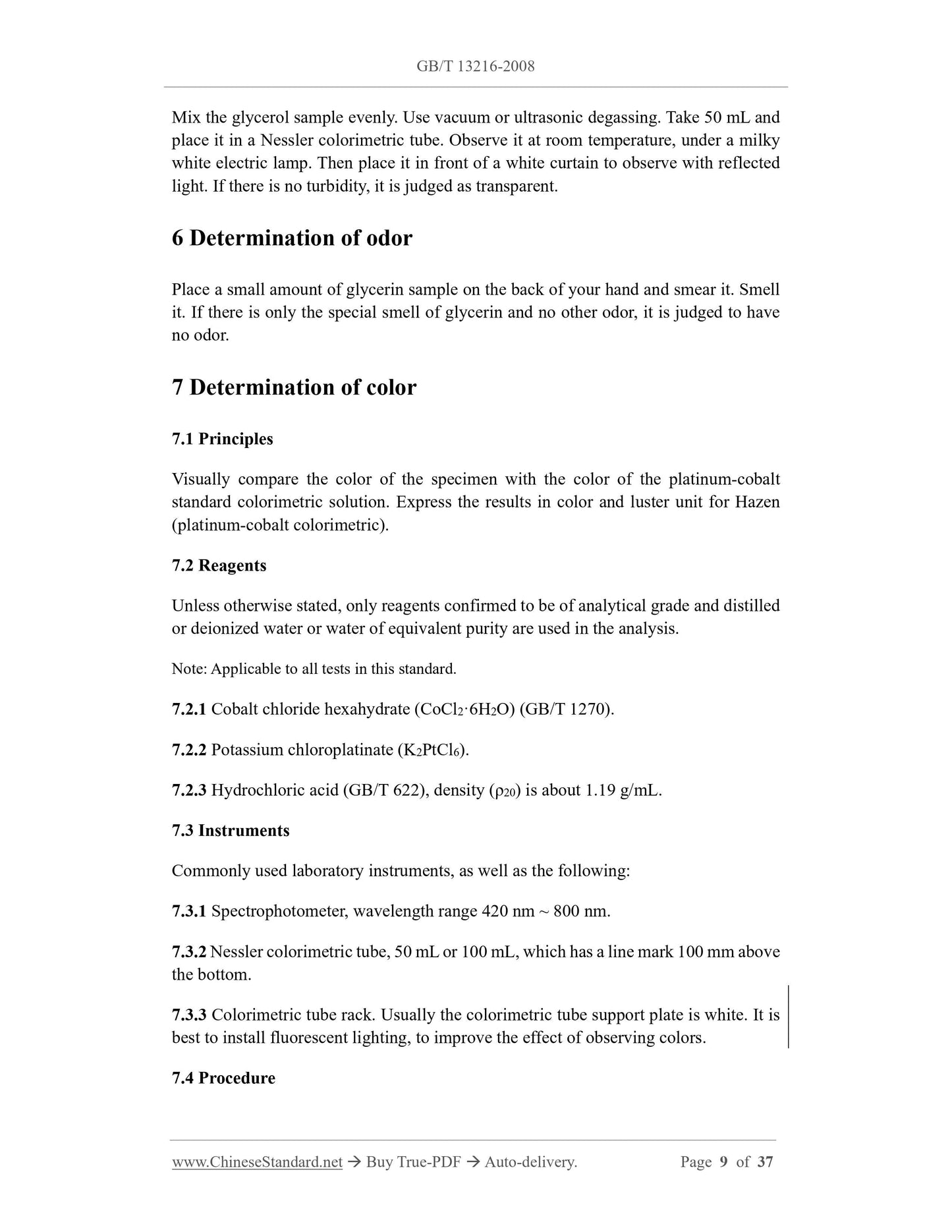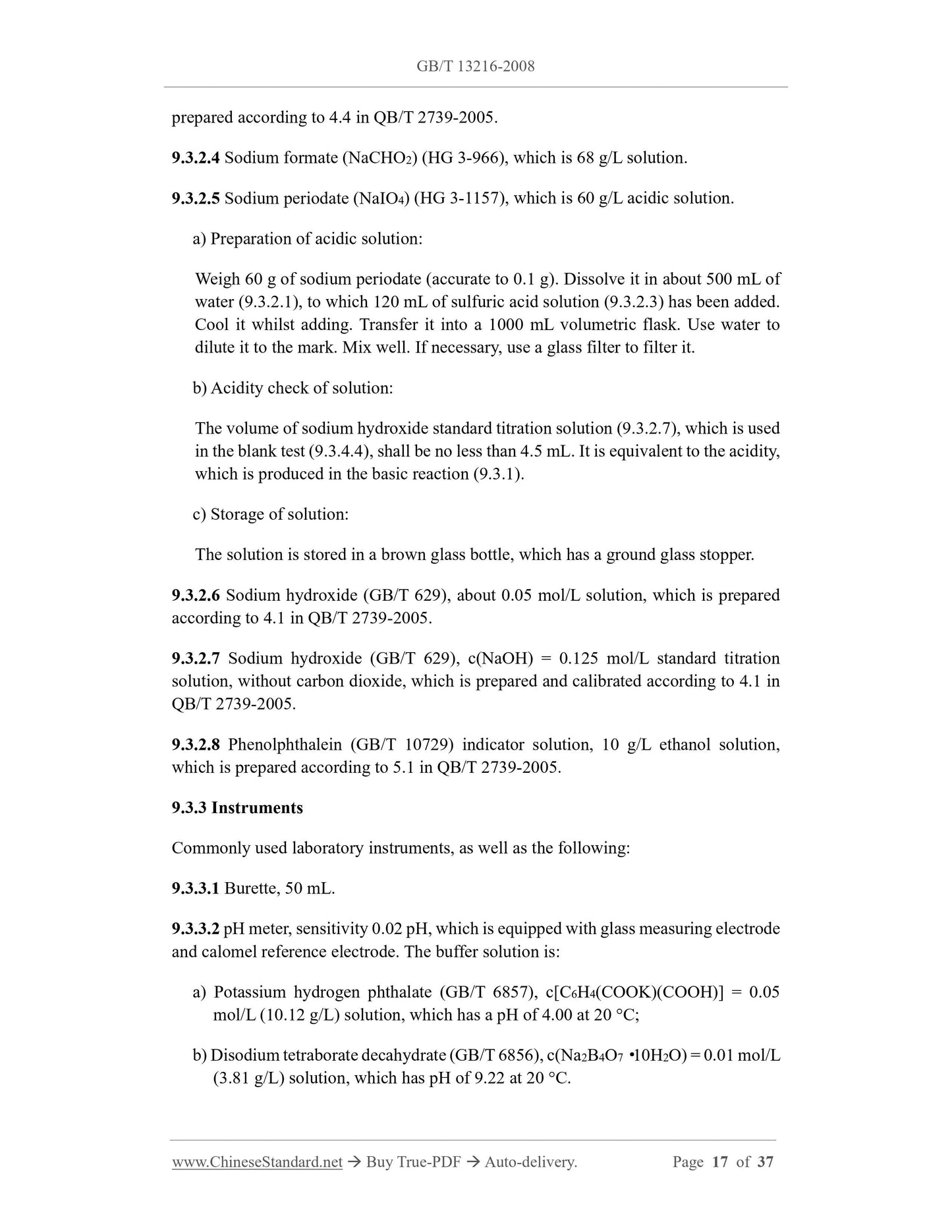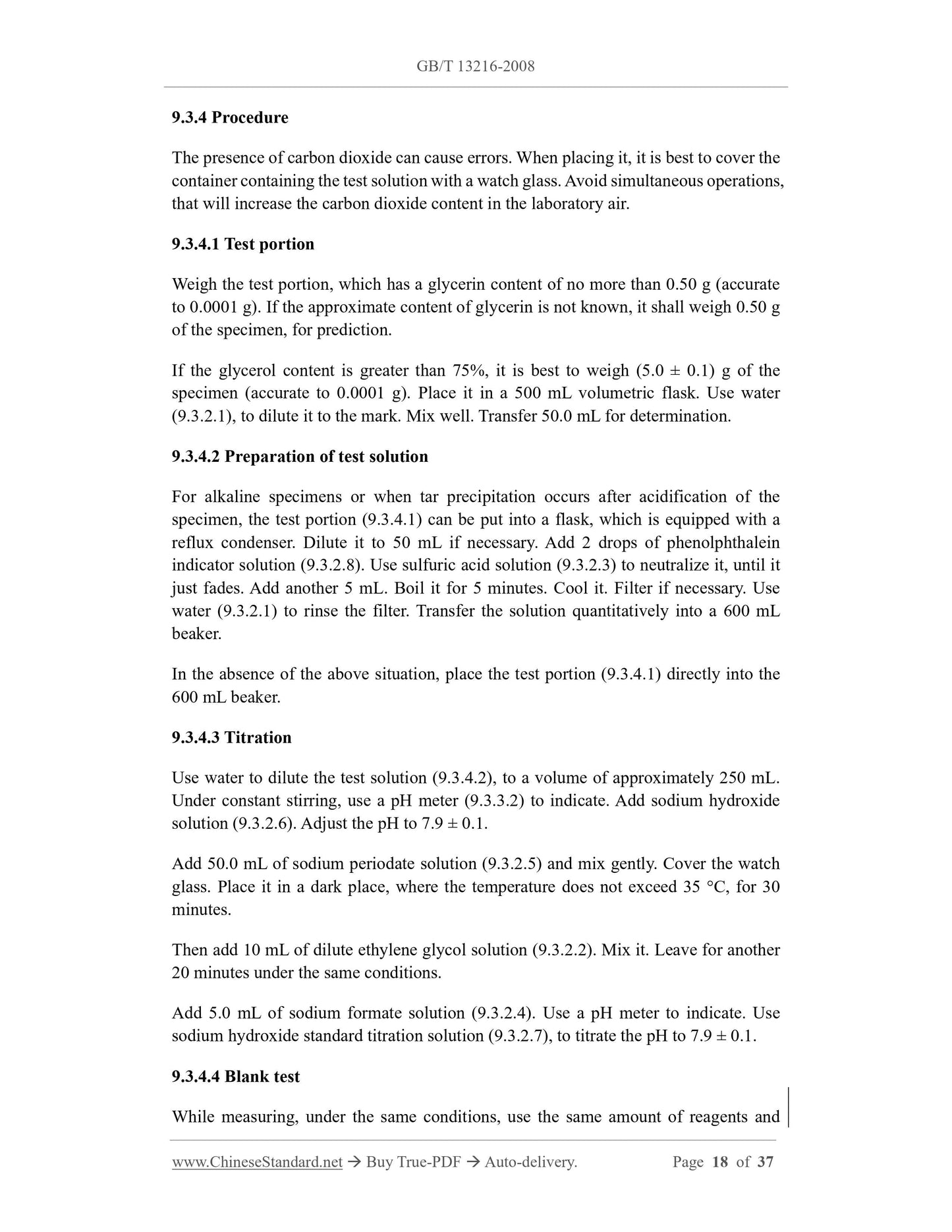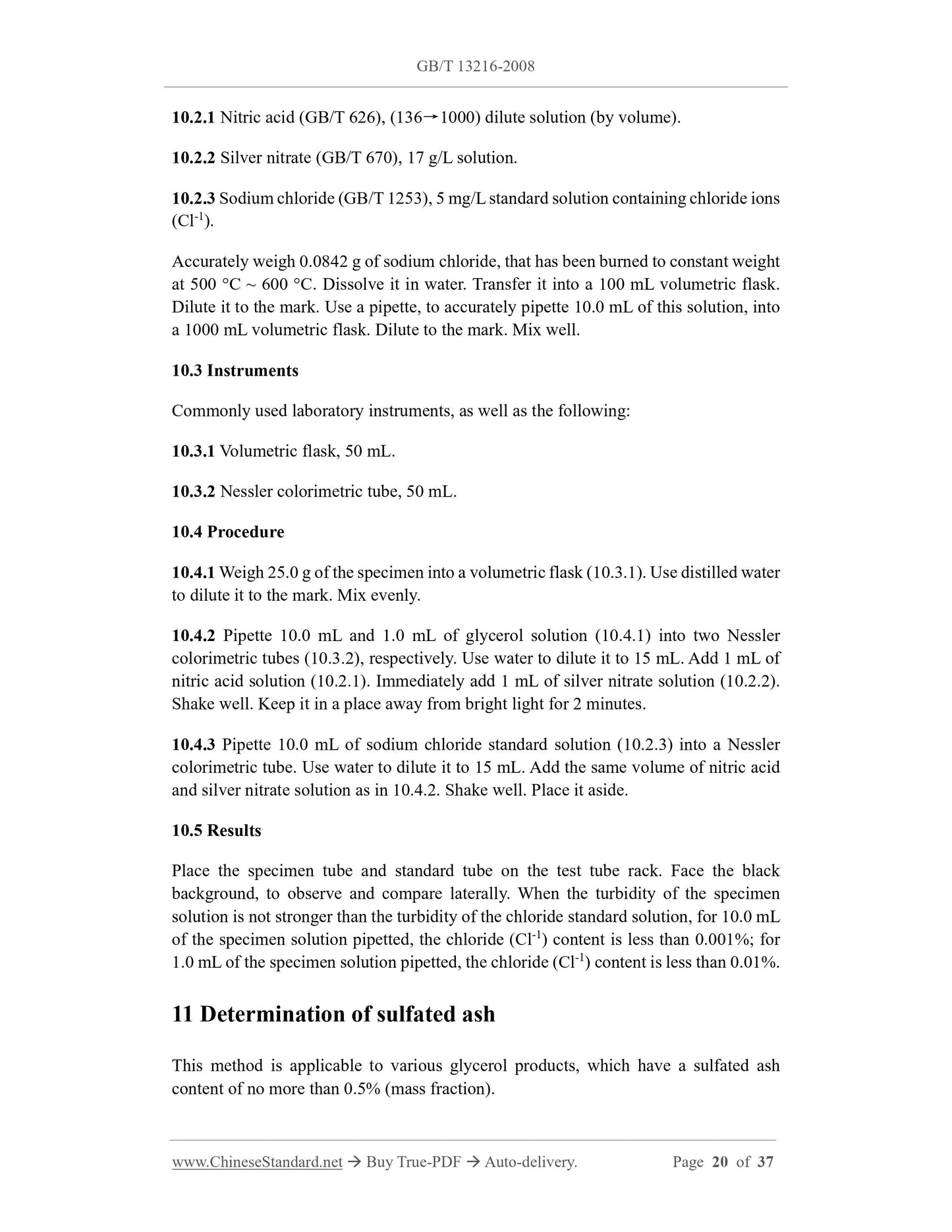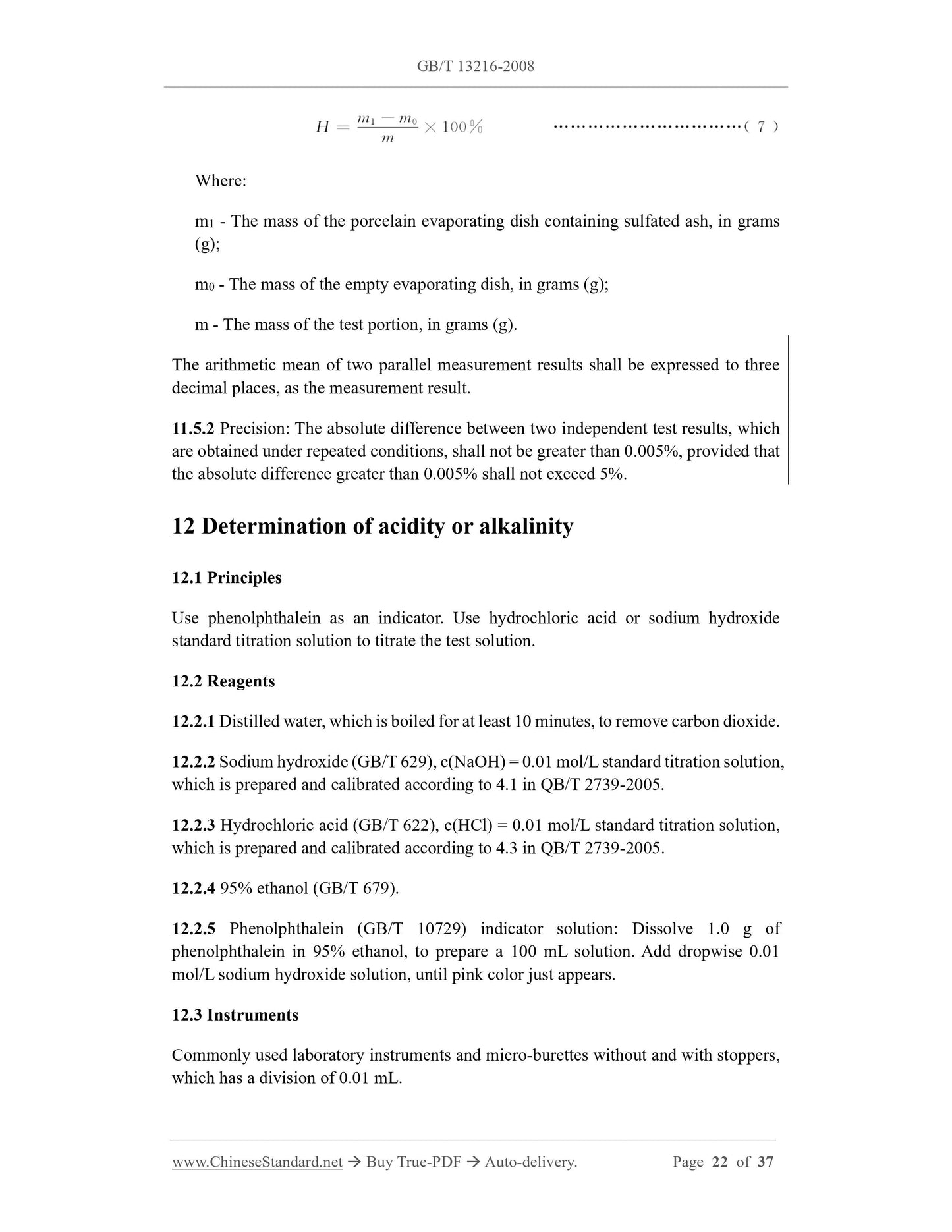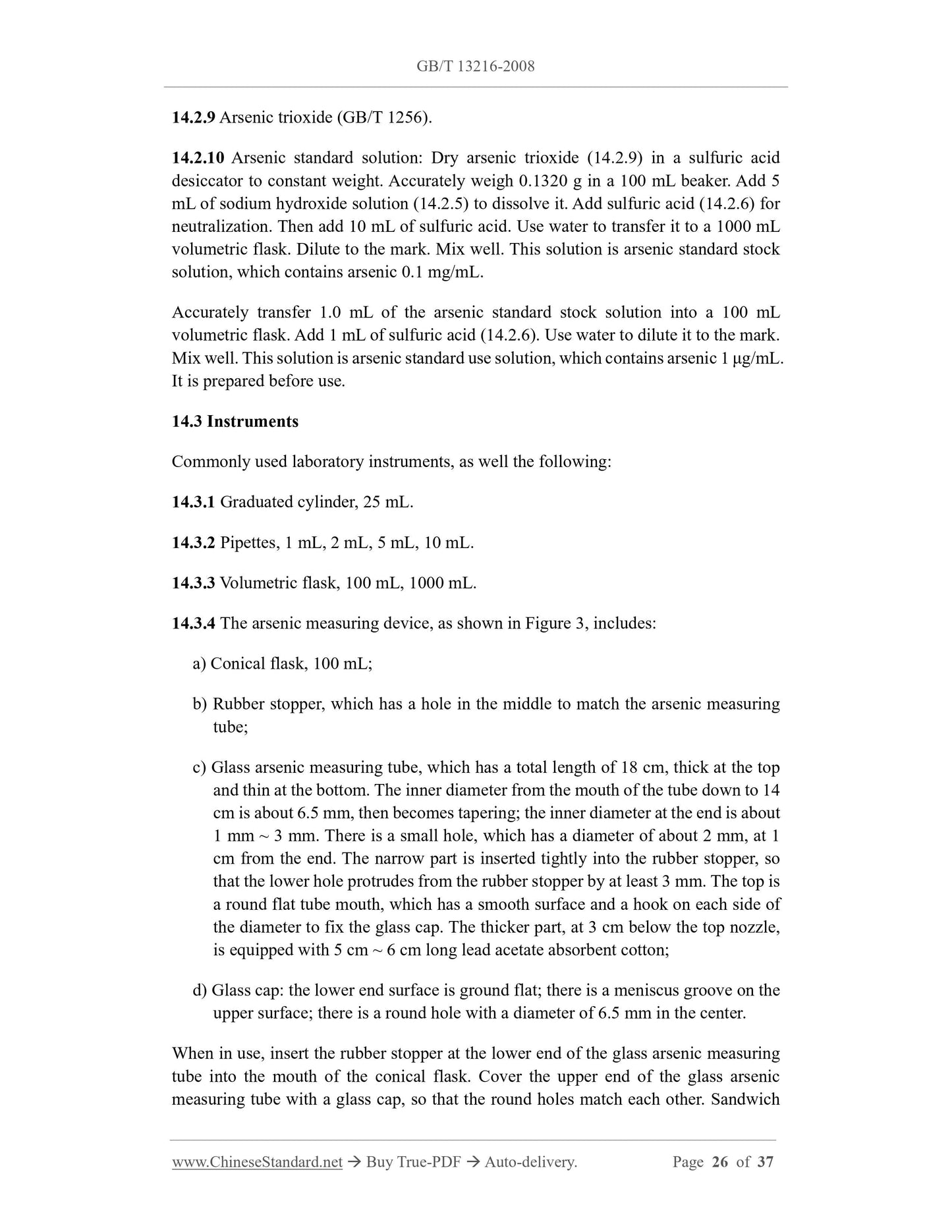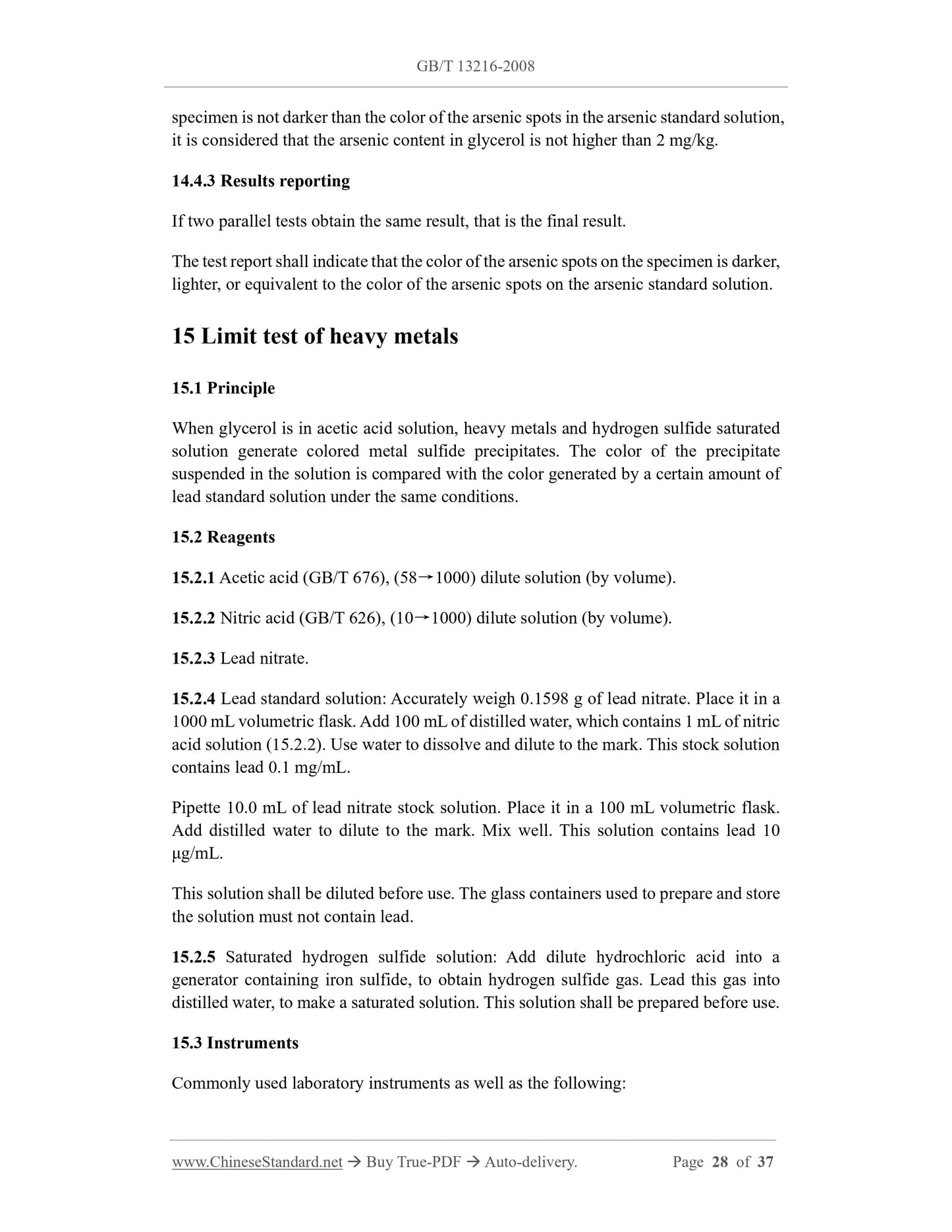1
/
of
12
PayPal, credit cards. Download editable-PDF and invoice in 1 second!
GB/T 13216-2008 English PDF (GBT13216-2008)
GB/T 13216-2008 English PDF (GBT13216-2008)
Regular price
$205.00 USD
Regular price
Sale price
$205.00 USD
Unit price
/
per
Shipping calculated at checkout.
Couldn't load pickup availability
Delivery: 3 seconds. Download true-PDF + Invoice.
Get QUOTATION in 1-minute: Click GB/T 13216-2008
Historical versions: GB/T 13216-2008
Preview True-PDF (Reload/Scroll if blank)
GB/T 13216-2008: Test methods for glycerine
GB/T 13216-2008
GB
NATIONAL STANDARD OF THE
PEOPLE’S REPUBLIC OF CHINA
ICS 71.080.70
Y 43
Replacing GB/T 13216.1 ~ 13216.13-1991
Test methods for glycerin
(ISO 1615:1976, ISO 1616:1976, ISO 2096:1972, ISO 2099:1972, ISO 2211:1973,
ISO 2879:1975, MOD)
[Including Amendment No.1]
ISSUED ON: MAY 28, 2008
IMPLEMENTED ON: DECEMBER 01, 2008
Issued by: General Administration of Quality Supervision, Inspection and
Quarantine of PRC;
National Standardization Administration.
Table of Contents
Foreword ... 3
1 Scope ... 5
2 Normative references ... 5
3 Terms and definitions ... 5
4 Sampling method of barreled glycerin ... 5
5 Determination of transparency ... 8
6 Determination of odor ... 9
7 Determination of color ... 9
8 Determination of density at 20 °C ... 11
9 Determination of glycerol content ... 13
10 Limit test for chloride ... 19
11 Determination of sulfated ash ... 20
12 Determination of acidity or alkalinity ... 22
13 Determination of saponification equivalent ... 23
14 Limit test for arsenic ... 25
15 Limit test of heavy metals ... 28
16 Tests for reducing substances ... 29
17 Test results reporting requirements ... 30
Appendix A (Informative) Corresponding information between clauses of this standard
and ISO standards ... 31
Amendment No.1 ... 37
Test methods for glycerin
1 Scope
This standard specifies the sampling method of barreled glycerol, as well as the method
for the determination of its transparency, odor, color, density at 20 °C, content, chloride
limits, sulfated ash, acidity or alkalinity, saponification equivalent, arsenic limits, heavy
metal limits, reduction substances.
2 Normative references
The provisions in following documents become the provisions of this Standard through
reference in this Standard. For the dated references, the subsequent amendments
(excluding corrections) or revisions do not apply to this Standard; however, parties who
reach an agreement based on this Standard are encouraged to study if the latest versions
of these documents are applicable. For undated references, the latest edition of the
referenced document applies.
QB/T 2739-2005 Preparations of standard volumetric solutions of general test
methods for washing products
3 Terms and definitions
The following terms and definitions apply to this standard.
3.1
Color and luster unit for Hazen
The color of solution, each liter of which contains 1 mg of platinum (calculated as
chloroplatinic acid) and 2 mg of cobalt chloride hexahydrate.
3.2
Density at 20 °C
The mass of material per unit volume at 20 °C, expressed in grams per milliliter.
4 Sampling method of barreled glycerin
4.1 General
This method is suitable for refined glycerol, which has no solid sedimentation or
suspended matter in the barrel. It is also applicable to barreled refined glycerin, that has
been frozen and can return to its original state after being warmed.
Samples for laboratory measurement are prepared and stored according to this method.
4.2 Principle
Insert the sampling tube from the plug hole to the bottom of the barrel. Take samples
from the entire depth of the barrel. Take an equal amount of samples from each sample
barrel. Combine all samples from the same batch. Mix evenly. Divide the samples into
the required number of laboratory samples.
4.3 Instruments
4.3.1 Sampling tube
As shown in Figure 1. It consists of two cylinders made of stainless steel or other
chemical-resistant materials. The inner cylinder and the outer cylinder are closely
matched. There are two rows of staggered and intermittent longitudinal grooves on each
of the two cylinders. The width of the groove accounts for one quarter of the
circumference of the cylinder; the length of the grooves is equally distributed over the
entire length of the cylinder. The grooves on the inner cylinder and the outer cylinder
can be exactly coincident or sealed, by turning the inner cylinder handle with a pointer.
The position indicated by the pointer on the scale, which is equipped on the outer
cylinder, means the relative position of the grooves on the inner cylinder and the outer
cylinder. In the "filling" position, the inner and outer grooves form two rows of
staggered openings, allowing samples from all depths in the barrel to enter the sampling
tube at the same time.
There are holes drilled in the bottom of the inner and outer cylinders. When the pointer
is in the "empty" position, the bottom holes overlap to form an opening, whilst the
longitudinal groove remains sealed.
The length of the sampling tube shall be proportional to the depth of the material to be
sampled; its effective volume shall be approximately 0.1% of the barrel volume.
4.3.2 Wipe plug
Match the plug hole of the barrel to be sampled.
4.3.3 Cylindrical collector
It is made of the same material as the sampling tube, but preferably glass; it is equipped
with a sealing cover, has a volume of about 1.5 L, can be applied to each ton of product
to be sampled.
4.4.1.1 Containers used for mixing and storing samples shall be sealed. The containers
shall be kept closed during filling AND in the operation space for taking each sample.
4.4.1.2 When sampling, the container shall be shielded as much as possible, especially
to prevent rain and other accidental contamination.
4.4.1.3 All instruments and containers shall be clean and dry when used.
4.4.1.4 The laboratory sample, which is obtained by dividing the mixed sample, shall
completely fill the sample bottle (4.3.4).
4.4.2 Sample preparation
Insert the sampling tube (4.3.1), whose groove hole is closed, into the bottom of the
barrel, through the wiper plug (4.3.2). Rotate the handle, to move the pointer to the
"filling" position. Open the longitudinal groove. Close the groove hole, after the
sampling tube is full. Pull out the sampling tube. Use the wiper plug to clean the outer
wall of the tube.
Insert the sampling tube, which is filled with glycerin, into the collector (4.3.3). Rotate
the handle, to move the pointer to the "empty" position. Empty the sampling tube. In
this way, take equal amounts of samples from each sample barrel in sequence, so that
the total amount is greater than the required amount. In the interval between the two
emptying operations, it must keep the collector closed.
Seal the sample container. Lie down and roll it. Quickly mix all the sample.
Immediately take about 500 g (or other required amounts) of the sample and put it into
a sample bottle (4.3.4), thus preparing the required number of sets of the same
laboratory sample. Tighten the stopper or sealing cap. Seal with sealing wax (or glue).
Attach the sample label, which indicates sample name, batch number, specifications,
sampling date, signature of the sampler.
If the glycerin in the sample barrel has been frozen due to freezing, the barrel shall be
gently heated and rolled over, to allow the glycerin to thaw and mix evenly, before
sampling as described above.
5 Determination of transparency
5.1 Instruments
Commonly used laboratory instruments, as well as the following:
5.1.1 Nessler colorimetric tube, 50 mL.
5.1.2 Milky white electric lamp.
5.2 Procedure
Mix the glycerol sample evenly. Use vacuum or ultrasonic degassing. Take 50 mL and
place it in a Nessler colorimetric tube. Observe it at room temperature, under a milky
white electric lamp. Then place it in front of a white curtain to observ...
Get QUOTATION in 1-minute: Click GB/T 13216-2008
Historical versions: GB/T 13216-2008
Preview True-PDF (Reload/Scroll if blank)
GB/T 13216-2008: Test methods for glycerine
GB/T 13216-2008
GB
NATIONAL STANDARD OF THE
PEOPLE’S REPUBLIC OF CHINA
ICS 71.080.70
Y 43
Replacing GB/T 13216.1 ~ 13216.13-1991
Test methods for glycerin
(ISO 1615:1976, ISO 1616:1976, ISO 2096:1972, ISO 2099:1972, ISO 2211:1973,
ISO 2879:1975, MOD)
[Including Amendment No.1]
ISSUED ON: MAY 28, 2008
IMPLEMENTED ON: DECEMBER 01, 2008
Issued by: General Administration of Quality Supervision, Inspection and
Quarantine of PRC;
National Standardization Administration.
Table of Contents
Foreword ... 3
1 Scope ... 5
2 Normative references ... 5
3 Terms and definitions ... 5
4 Sampling method of barreled glycerin ... 5
5 Determination of transparency ... 8
6 Determination of odor ... 9
7 Determination of color ... 9
8 Determination of density at 20 °C ... 11
9 Determination of glycerol content ... 13
10 Limit test for chloride ... 19
11 Determination of sulfated ash ... 20
12 Determination of acidity or alkalinity ... 22
13 Determination of saponification equivalent ... 23
14 Limit test for arsenic ... 25
15 Limit test of heavy metals ... 28
16 Tests for reducing substances ... 29
17 Test results reporting requirements ... 30
Appendix A (Informative) Corresponding information between clauses of this standard
and ISO standards ... 31
Amendment No.1 ... 37
Test methods for glycerin
1 Scope
This standard specifies the sampling method of barreled glycerol, as well as the method
for the determination of its transparency, odor, color, density at 20 °C, content, chloride
limits, sulfated ash, acidity or alkalinity, saponification equivalent, arsenic limits, heavy
metal limits, reduction substances.
2 Normative references
The provisions in following documents become the provisions of this Standard through
reference in this Standard. For the dated references, the subsequent amendments
(excluding corrections) or revisions do not apply to this Standard; however, parties who
reach an agreement based on this Standard are encouraged to study if the latest versions
of these documents are applicable. For undated references, the latest edition of the
referenced document applies.
QB/T 2739-2005 Preparations of standard volumetric solutions of general test
methods for washing products
3 Terms and definitions
The following terms and definitions apply to this standard.
3.1
Color and luster unit for Hazen
The color of solution, each liter of which contains 1 mg of platinum (calculated as
chloroplatinic acid) and 2 mg of cobalt chloride hexahydrate.
3.2
Density at 20 °C
The mass of material per unit volume at 20 °C, expressed in grams per milliliter.
4 Sampling method of barreled glycerin
4.1 General
This method is suitable for refined glycerol, which has no solid sedimentation or
suspended matter in the barrel. It is also applicable to barreled refined glycerin, that has
been frozen and can return to its original state after being warmed.
Samples for laboratory measurement are prepared and stored according to this method.
4.2 Principle
Insert the sampling tube from the plug hole to the bottom of the barrel. Take samples
from the entire depth of the barrel. Take an equal amount of samples from each sample
barrel. Combine all samples from the same batch. Mix evenly. Divide the samples into
the required number of laboratory samples.
4.3 Instruments
4.3.1 Sampling tube
As shown in Figure 1. It consists of two cylinders made of stainless steel or other
chemical-resistant materials. The inner cylinder and the outer cylinder are closely
matched. There are two rows of staggered and intermittent longitudinal grooves on each
of the two cylinders. The width of the groove accounts for one quarter of the
circumference of the cylinder; the length of the grooves is equally distributed over the
entire length of the cylinder. The grooves on the inner cylinder and the outer cylinder
can be exactly coincident or sealed, by turning the inner cylinder handle with a pointer.
The position indicated by the pointer on the scale, which is equipped on the outer
cylinder, means the relative position of the grooves on the inner cylinder and the outer
cylinder. In the "filling" position, the inner and outer grooves form two rows of
staggered openings, allowing samples from all depths in the barrel to enter the sampling
tube at the same time.
There are holes drilled in the bottom of the inner and outer cylinders. When the pointer
is in the "empty" position, the bottom holes overlap to form an opening, whilst the
longitudinal groove remains sealed.
The length of the sampling tube shall be proportional to the depth of the material to be
sampled; its effective volume shall be approximately 0.1% of the barrel volume.
4.3.2 Wipe plug
Match the plug hole of the barrel to be sampled.
4.3.3 Cylindrical collector
It is made of the same material as the sampling tube, but preferably glass; it is equipped
with a sealing cover, has a volume of about 1.5 L, can be applied to each ton of product
to be sampled.
4.4.1.1 Containers used for mixing and storing samples shall be sealed. The containers
shall be kept closed during filling AND in the operation space for taking each sample.
4.4.1.2 When sampling, the container shall be shielded as much as possible, especially
to prevent rain and other accidental contamination.
4.4.1.3 All instruments and containers shall be clean and dry when used.
4.4.1.4 The laboratory sample, which is obtained by dividing the mixed sample, shall
completely fill the sample bottle (4.3.4).
4.4.2 Sample preparation
Insert the sampling tube (4.3.1), whose groove hole is closed, into the bottom of the
barrel, through the wiper plug (4.3.2). Rotate the handle, to move the pointer to the
"filling" position. Open the longitudinal groove. Close the groove hole, after the
sampling tube is full. Pull out the sampling tube. Use the wiper plug to clean the outer
wall of the tube.
Insert the sampling tube, which is filled with glycerin, into the collector (4.3.3). Rotate
the handle, to move the pointer to the "empty" position. Empty the sampling tube. In
this way, take equal amounts of samples from each sample barrel in sequence, so that
the total amount is greater than the required amount. In the interval between the two
emptying operations, it must keep the collector closed.
Seal the sample container. Lie down and roll it. Quickly mix all the sample.
Immediately take about 500 g (or other required amounts) of the sample and put it into
a sample bottle (4.3.4), thus preparing the required number of sets of the same
laboratory sample. Tighten the stopper or sealing cap. Seal with sealing wax (or glue).
Attach the sample label, which indicates sample name, batch number, specifications,
sampling date, signature of the sampler.
If the glycerin in the sample barrel has been frozen due to freezing, the barrel shall be
gently heated and rolled over, to allow the glycerin to thaw and mix evenly, before
sampling as described above.
5 Determination of transparency
5.1 Instruments
Commonly used laboratory instruments, as well as the following:
5.1.1 Nessler colorimetric tube, 50 mL.
5.1.2 Milky white electric lamp.
5.2 Procedure
Mix the glycerol sample evenly. Use vacuum or ultrasonic degassing. Take 50 mL and
place it in a Nessler colorimetric tube. Observe it at room temperature, under a milky
white electric lamp. Then place it in front of a white curtain to observ...
Share
